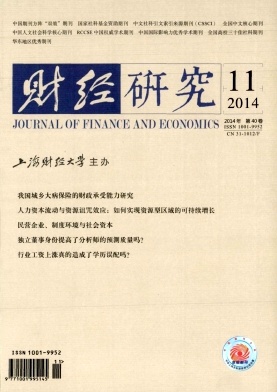人力资本流动与资源诅咒效应:如何实现资源型区域的可持续增长
财经研究 2014 年 第 40 卷第 11 期, 页码:44 - 60
摘要
参考文献
摘要
人力资本的流动性和自然资源的耗竭性对资源型区域的可持续增长具有至关重要的影响。文章针对现有研究的重要缺陷,在对现有模型进行改进和扩展的基础上,纳入人力资本跨区域流动的条件,构建了一个以资源开发和输出为导向的区域经济三部门内生增长模型,对资源诅咒效应的发生机制进行了理论阐释并讨论了人力资本外流对资源型区域经济增长的影响;进而在考虑资源型区域"二元"产业结构特征的框架下,讨论了资源型区域实现经济可持续增长的必要条件。研究发现,人力资本外流会降低社会计划者增强人力资本积累的积极性,从而增加了资源型区域发生资源诅咒效应的风险,但是资源诅咒效应的发生并非必然,足够大的生产要素替代弹性是资源诅咒被有效规避的充分条件;人力资本外流对资源型区域的经济增长具有双重效应,消费者的边际效用弹性所反映的教育投资倾向的大小,是其正向激励效应是否居于主导地位的决定性因素;在考虑资源可耗竭的情形下,较大的边际效用弹性和较高的人力资本积累速度,是实现资源型区域经济可持续增长的必要保障。
[1]樊潇彦,袁志刚.“宏观投资效率”研究:一个理论和实证的探索[C].第五届中国经济学年会参会论文,2005.
[2]贺秋硕.劳动力流动与收入收敛——一个改进的新古典增长模型及对中国的启示[J].财经研究,2005,(10):137-144.
[3]胡援成,肖德勇.经济发展门槛与自然资源诅咒——基于我国省际层面的面板数据实证研究[J].管理世界,2007,(4):15-23.
[4]彭水军.自然资源耗竭与经济可持续增长:基于四部门内生增长模型分析[J].管理工程学报,2007,(4):119-124.
[5]邵帅,齐中英.西部地区的能源开发与经济增长——基于“资源诅咒”假说的实证分析[J].经济研究,2008(4):147-160.
[6]邵帅,杨莉莉.自然资源丰裕、资源产业依赖与中国区域经济增长[J].管理世界,2010,(9):26-44.
[7]邵帅,杨莉莉.自然资源开发、内生技术进步与区域经济增长[J].经济研究,2011,(S2):12-23.
[8]王美红,孙根年,康国栋.我国自然资本、人力资本与经济资本的空间错位分析[J].科学学研究,2009,(1):59-65.
[9]武芳梅.“资源的诅咒”与经济发展——基于山西省的典型分析[J].经济问题,2007,(10):24-27.
[10]许士春,何正霞,魏晓平.资源消耗、污染控制下经济可持续最优增长路径[J].管理科学学报,2010,(1):20-30.
[11]Asea P K,Lahiri A.The precious bane[J].Journal of Economic Dynamics and Control,1999,23(5-6):823-849.
[12]Bravo-Ortega C,De Gregorio J.The relative richness of the poorNatural resources,human capital and economic growth[A].Lederman D,Maloney W.Natural Resources,Neither Curse nor Destiny[C].Washington DC:World Bank,2007.
[13]Chen H.A brain gain or a brain drain Migration,endogenous fertility,and human capital formation[J].Economic Inquiry,2009,47(4):766-782.
[14]Dahlman C J,Routti J,Yla-Anttila P.Finland as a knowledge economy:Elements of success and lessons learned[R].Washington DC:World Bank,2007.
[15]Dustmann C,Fadlon I,Weiss Y.Return migration,human capital accumulation and the brain drain[J].Journal of Development Economics,2011,95(1):58-67.
[16]Gylfason T.Natural resources,education,and economic development[J].European Economic Review,2001,45(4-6):847-859.
[17]Kurtz M J,Brooks S M.Conditioning the“resource curse”:Globalization,human capital,and growth in oil-rich nations[J].Comparative Political Studies,2011,44(d):747-770.
[18]Lafforgue G.Stochastic technical change,non-renewable resource and optimal sustainable growth[J].Resource and Energy Economics,2008,30(4):540-554.
[19]Lucas R E.On the mechanics of economic development[J].Journal of Monetary Economics,1988,22(1):3-42.
[20]Maria C D,Stryszowski P.Migration,human capital accumulation and economic development[J].Journal of Development Economics,2009,90(2):306-313.
[21]Mountford A.Can a brain drain be good for growth in the source economy[J].Journal of Development Economics,1997,53(2):287-303.
[22]Papyrakis E,Gerlagh R.The resource curse hypothesis and its transmission channels[J].Journal of Comparative Economics,2004,32(1):181-193.
[23]Sachs J D,Warner A M.Natural resource abundance and economic growth[R].NBER Working Paper No.5398,1995.
[24]Sachs J D,Warner A M.Natural resources and economic development:The curse of natural resources[J].European Economic Review,2001,45(4-6):827-838.
[25]Shao S,Yang L.Natural resource dependence,human capital accumulation,and Economic growth:a combined explanation for the resource curse and the resource blessing[J].Energy Policy,2014,in press,DOI:10.1016/j.enpol.2014.07.007.
[26]Stiglitz J.Growth with exhaustible natural resources:efficient and optimal growth Paths[J].Review of Economic Studies,1974,41:123-137.
[27]van der Ploeg F,Poelhekke S.The pungent smell of“red herrings”:Subsoil assets,rents,volatility and the resource curse[J].Journal of Environmental Economics and Management,2010,60(1):44-55.
[28]van Zon A,Yetkiner I H.An endogenous growth model with embodied energy-saving technical change[J].Resource and Energy Economics,2003,25(1):81-103.
1考虑到模型的复杂性和技术可行性,这里并未考虑人力资本流动的情形,但可以预见这对基本结论不会产生实质影响。
[2]贺秋硕.劳动力流动与收入收敛——一个改进的新古典增长模型及对中国的启示[J].财经研究,2005,(10):137-144.
[3]胡援成,肖德勇.经济发展门槛与自然资源诅咒——基于我国省际层面的面板数据实证研究[J].管理世界,2007,(4):15-23.
[4]彭水军.自然资源耗竭与经济可持续增长:基于四部门内生增长模型分析[J].管理工程学报,2007,(4):119-124.
[5]邵帅,齐中英.西部地区的能源开发与经济增长——基于“资源诅咒”假说的实证分析[J].经济研究,2008(4):147-160.
[6]邵帅,杨莉莉.自然资源丰裕、资源产业依赖与中国区域经济增长[J].管理世界,2010,(9):26-44.
[7]邵帅,杨莉莉.自然资源开发、内生技术进步与区域经济增长[J].经济研究,2011,(S2):12-23.
[8]王美红,孙根年,康国栋.我国自然资本、人力资本与经济资本的空间错位分析[J].科学学研究,2009,(1):59-65.
[9]武芳梅.“资源的诅咒”与经济发展——基于山西省的典型分析[J].经济问题,2007,(10):24-27.
[10]许士春,何正霞,魏晓平.资源消耗、污染控制下经济可持续最优增长路径[J].管理科学学报,2010,(1):20-30.
[11]Asea P K,Lahiri A.The precious bane[J].Journal of Economic Dynamics and Control,1999,23(5-6):823-849.
[12]Bravo-Ortega C,De Gregorio J.The relative richness of the poorNatural resources,human capital and economic growth[A].Lederman D,Maloney W.Natural Resources,Neither Curse nor Destiny[C].Washington DC:World Bank,2007.
[13]Chen H.A brain gain or a brain drain Migration,endogenous fertility,and human capital formation[J].Economic Inquiry,2009,47(4):766-782.
[14]Dahlman C J,Routti J,Yla-Anttila P.Finland as a knowledge economy:Elements of success and lessons learned[R].Washington DC:World Bank,2007.
[15]Dustmann C,Fadlon I,Weiss Y.Return migration,human capital accumulation and the brain drain[J].Journal of Development Economics,2011,95(1):58-67.
[16]Gylfason T.Natural resources,education,and economic development[J].European Economic Review,2001,45(4-6):847-859.
[17]Kurtz M J,Brooks S M.Conditioning the“resource curse”:Globalization,human capital,and growth in oil-rich nations[J].Comparative Political Studies,2011,44(d):747-770.
[18]Lafforgue G.Stochastic technical change,non-renewable resource and optimal sustainable growth[J].Resource and Energy Economics,2008,30(4):540-554.
[19]Lucas R E.On the mechanics of economic development[J].Journal of Monetary Economics,1988,22(1):3-42.
[20]Maria C D,Stryszowski P.Migration,human capital accumulation and economic development[J].Journal of Development Economics,2009,90(2):306-313.
[21]Mountford A.Can a brain drain be good for growth in the source economy[J].Journal of Development Economics,1997,53(2):287-303.
[22]Papyrakis E,Gerlagh R.The resource curse hypothesis and its transmission channels[J].Journal of Comparative Economics,2004,32(1):181-193.
[23]Sachs J D,Warner A M.Natural resource abundance and economic growth[R].NBER Working Paper No.5398,1995.
[24]Sachs J D,Warner A M.Natural resources and economic development:The curse of natural resources[J].European Economic Review,2001,45(4-6):827-838.
[25]Shao S,Yang L.Natural resource dependence,human capital accumulation,and Economic growth:a combined explanation for the resource curse and the resource blessing[J].Energy Policy,2014,in press,DOI:10.1016/j.enpol.2014.07.007.
[26]Stiglitz J.Growth with exhaustible natural resources:efficient and optimal growth Paths[J].Review of Economic Studies,1974,41:123-137.
[27]van der Ploeg F,Poelhekke S.The pungent smell of“red herrings”:Subsoil assets,rents,volatility and the resource curse[J].Journal of Environmental Economics and Management,2010,60(1):44-55.
[28]van Zon A,Yetkiner I H.An endogenous growth model with embodied energy-saving technical change[J].Resource and Energy Economics,2003,25(1):81-103.
1考虑到模型的复杂性和技术可行性,这里并未考虑人力资本流动的情形,但可以预见这对基本结论不会产生实质影响。
引用本文
杨莉莉, 邵帅. 人力资本流动与资源诅咒效应:如何实现资源型区域的可持续增长[J]. 财经研究, 2014, 40(11): 44–60.
导出参考文献,格式为:





 7449
7449  5261
5261

